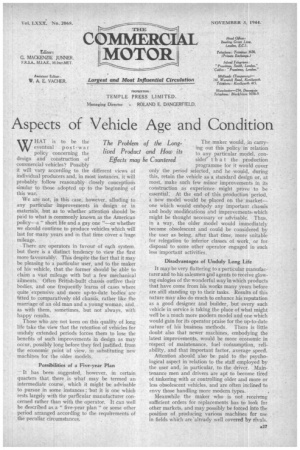Aspects of Vehicle Age and Condition
Page 19

If you've noticed an error in this article please click here to report it so we can fix it.
WHAT is to be the eventual post-war policy concerning the design and construction of commercial vehicles? Possibly it will vary according to the different views of individual producers and, in most instances, it will probably follow reasonably closely conceptions similar to those adopted up to the beginning of this war.
We are not, in this case, however, alluding to any particular improvements in design or in materials, but as to whether attention should be paid to what is commonly known as the American policy—a" short life and a gay one "—or whether we should continue to produce vehicles which will last for many years and in that time cover a huge mileage.
There are operators in favour of ea,ch system. but there is a distinct tendency to view the first more favourably. This despite the fact that it may be.pleasing to a particular user, and to the maker of his vehicle, that the former should be able to claim a vast mileage with but a few mechanical ailments. Often British-built chassis outlive their bodies, and one frequently learns of cases where quite 'expensive and more up-to-date bodies are fitted to comparatively old chassis, rather like the marriage of an old man and a young woman, and, as with them, sometimes, but not always, with happy results.
Those who Are not keen on this quality of long life take the view that the retention of vehicles for unduly extended periods forces them to lose the benefits of such improvements in design as may occur, possibly long before they feel justified, from the economic point of view, in substituting new machines for the older models.
Possibilities of a Five-year Nan It has been suggested, however, in certain quarters that there is what may be termed an intermediate course, which it might be advisable to pursue in some instances ; 'but it is one which rests largely with the parflcular manufacturer concerned rather than with the operator. It can well he described as a "five-year plan" or some other period arranged according to the requirements of the peculiar circumstances. The maker would, in carrying out this policy in relation to any particular model, consider' that the production programme for it would cover only the period selected, and he would, during this, retain the vehicle as a standard design or, at most, make such few minor improvements in its construction as experience might prove to be essential. At the end of this production period, a new model would be placed on the market— one which would embpdy any important chassis and body modifications and improvements: which might be thought necessary or advisable. Thus, in a way, the older Model would immediately become obsolescent and could be considered by the user as being, after that time, more suitable for relegation to inferior classes of work, or for disposal to some other operator engaged in such less important activities.
of the Longand How its be Countered
Disadvantages of Unduly Long Life It may be very flattering to a particular manufacturer and to his salesmen gnd agents to receive glowing eulogies of the wonderful .way in which products that have come from his works many years before are still standing up to their tasks. Results of this nature may also do much to enhance his reputation as a good designer and builder, but every such vehicle in service is taking the place of what might well be a much more modern model and one which %vould gain for its operator praise for the up-to-date nature of his business methods. There is little doubt also that newer machines, embodying the latest improvements, would be more economic in respect of maintenance, fuel consumption, reliability, and that important factor, average speed.
Attention should also be paid to the psychological aspect in relation to the staff employed by the user and, in particular, to the driver. Maintenance men and drivers are apt to become tired of tinkering with or controlling older and more or less obsolescent vehicles, and are often inclined to envy those handling more modern types.
Meanwhile the maker who is not receiving sufficient orders for replacements has to look for other markets, and may possibly be forced into the position of producing various machines for use in fields which are already well covered by rivals.




















































